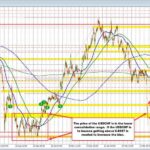
Navigating the Future: Fed Interest Rate Cuts and Economic Trends for 2025
Tháng 4 4, 2025
Navigating the Storm: USDCHF Currency Pair Under Pressure as Exchange Rate Plummets
Tháng 4 4, 2025Escalating Trade Tensions: Trump’s New Tariffs on China and Their Implications
Former President Donald Trump’s recent comments on China’s response to the newly imposed tariffs reveal his perspective on the ongoing trade tensions between the United States and China. Claiming that “China played it wrong” and “panicked” in the face of these tariffs, Trump suggests that their reactions may adversely impact their own economic position. These remarks come in the context of substantial tariffs he has announced on Chinese goods, further complicating the already strained trade relationship between the two nations.
Significant Tariff Developments
On April 2, 2025, Trump outlined an extensive set of tariffs on imports, including a striking 54% tariff on Chinese products. This substantial figure is composed of a new 34% reciprocal tariff in addition to a previously established 20% tariff. The stated objective of these tariffs is to address what Trump perceives as unfair trade practices employed by China and other global trading partners. Alongside these measures, a 10% universal tariff on all imports to the U.S. will take effect on April 5, 2025. Furthermore, selected countries will face increased tariffs ranging from 11% to 50%, with China being among the most significantly impacted.
Implications and Reactions from Global Stakeholders
Trump’s assertion that China’s government has overreacted indicates his belief that such responses could lead to detrimental decision-making regarding trade negotiations. This notion underscores the complexities and vulnerabilities inherent in U.S.-China trade relations, as both economies grapple with the far-reaching consequences of these tariffs. In response to these escalating tensions, China’s President Xi Jinping recently convened over 40 top global CEOs to address the situation and emphasized international stability and collaboration. This meeting highlighted China’s commitment to maintaining a favorable investment climate despite U.S. tariffs, showing its strategic approach to enhancing economic partnerships and playing a key role in global trade. Read more about Xi’s strategic moves here.
Despite both nations expressing a desire to engage in negotiations, substantial progress remains elusive. Recent discussions between U.S. Trade Representative Jamieson Greer and Chinese Vice Premier He Lifeng yielded little resolution, demonstrating the difficult climate surrounding trade talks. The lack of meaningful dialogue may suggest an impasse that could further exacerbate existing tensions, leaving both countries at a crossroads regarding future trade agreements.
The Uncertain Path Forward
As these tariffs take effect, the likelihood of reaching a trade agreement appears increasingly slim unless China makes significant concessions. Trump has previously indicated a willingness to revisit tariff structures if critical issues such as perceived trade imbalances are satisfactorily resolved. However, until such agreements are reached, the future of U.S.-China relations hangs in a delicate balance, with economic stability potentially at risk amid these escalating tensions.
In conclusion, Trump’s commentary on China’s reaction to the tariffs reflects a belief in the superiority of U.S. trade policies under his administration. The introduction of high tariffs and consequent retaliatory measures signals an ongoing escalation in trade confrontations, a situation that could disrupt global trade dynamics. As both nations navigate the ramifications of these tariffs, the potential for a durable resolution remains uncertain, drawing critical attention from global economic observers.
This evolving story in U.S.-China relations will continue to shape the landscape of international trade as both countries strive to find common ground amidst persistent tensions.

